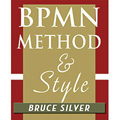Creating business process models that can be shared effectively across the business – and between business and IT – demands more than a digest of BPMN shapes and symbols. It requires a step-by-step methodology for going from zero to a complete process model. It also requires consistent application of a modeling style, so that the modeler’s meaning is clear from the diagram itself. Author Bruce Silver explains not only the meaning and proper usage of the entire BPMN 2.0 palette, but calls out the working subset that you really need to know. He also reveals the hidden assumptions of core concepts left unexplained in the spec, the key to BPMN’s deeper meaning.
The book addresses BPMN at three levels, with primary focus on the first two. Level 1, or descriptive BPMN, uses a restricted palette in combination with some relaxation of BPMN’s rules to meet the needs of business users doing basic process mapping. Level 2, or analytical BPMN, takes advantage of the notation’s exceptional expressiveness for detailing event and exception handling, key to analyzing and improving process performance and quality. Level 3, or executable BPMN, is brand new in BPMN 2.0. Here the XML underneath the diagram shapes can be deployed to a process engine to actually execute the model. The method and style recommended by the book aligns these three levels, facilitating business-IT collaboration throughout the process lifecycle.
Inside the book you’ll find detailed discussions, illustrated with over 100 examples, about:
- The questions BPMN asks, and does not ask
- The meaning of basic concepts like starting and completing, sending and receiving, waiting and listening
- Subprocesses and hierarchical modeling style
- The five basic steps in creating Level 1 models
- Event and exception-handling patterns
- Branching and merging patterns
- Level 2 modeling method
- Elements of BPMN style: element usage and diagram composition

















